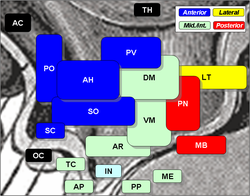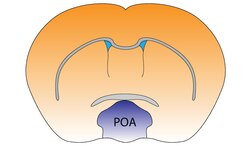Preoptic area
| Preoptic area | |
|---|---|

Preoptic area is 'PO', at left, in blue.
|
|

Preoptic area of the mouse brain
|
|
| Details | |
| Identifiers | |
| Latin | Area praeoptica |
| MeSH | A08.186.211.730.385.357.342.450 |
| NeuroNames | hier-360 |
| NeuroLex ID | Preoptic Area |
| TA | A14.1.08.407 |
| FMA | 62313 |
|
Anatomical terms of neuroanatomy
[]
|
|
The preoptic area (also called POA) is a region of the hypothalamus. According to the MeSH classification, it is considered part of the anterior hypothalamus. There are four nuclei in this region, according to Terminologia Anatomica (medial, median, lateral, and periventricular).
The preoptic area is responsible for thermoregulation and receives nervous stimulation from thermoreceptors in the skin, mucous membranes, and hypothalamus itself.
This area propagates stimuli to either the heat-losing or the heat-promoting centers of the hypothalamus.
The median preoptic nucleus is located along the midline in a position significantly dorsal to the other 3 preoptic nuclei, at least in the macaca fascicularis brain. It wraps around the top (dorsal), front, and bottom (ventral) surfaces of the anterior commissure.
The median preoptic nucleus generates thirst. Drinking decreases noradrenaline release in the median preoptic nucleus.
The medial preoptic nucleus is bounded laterally by the lateral preoptic nucleus, and medially by the preoptic periventricular nucleus. It releases gonadotropin-releasing hormone (GnRH), controls copulation in males, and is larger in males than in females.
The medial preoptic area (mPOA) has been implicated in parental care in both males and females. In rats, and vasopressin are associated with maintaining maternal care through local release in the mPOA and the adjacent bed nucleus of the stria terminalis (BNST). Oxytocin and vasopressin V1a receptor binding are increased in both the mPOA and the BNST in lactating rats when compared to controls. The mPOA also has a high density of estradiol receptors that, when activated, can cause a male rat to show maternal-type behaviors. Additionally, the mPOA is critical for the onset and expression of parental behavior, as evidenced by increases in the immediate early gene c-fos, in experienced rat mothers or fathers when compared to controls. Also in fathers, studies have shown that when they receive ultrasonic or pheromone cues from their mates, their c-fos expression in the mPOA further increased, suggestive that rat paternal behavior is mediated through the mPOA but activated by direct interactions with a mate. Large lesions of the mPOA disrupt the onset of maternal behavior, nest-building, and pup retrieval, with the lateral projections being especially critical.
...
Wikipedia
